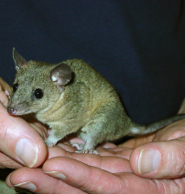 The Gray short-tailed opossum (Monodelphis domestica) is a remarkable marsupial because it is one of the only marsupials where the females do not have a pouch. Their newborns just hang on the mother's teats. Due to the inadequacies of the functions of the newborn's immune system, scientists use them for cancer research and general immune system development. Short-tailed opossums are much like humans in the way that they can can develop skin cancer from sunlight alone. They can be found inhabiting or frequenting trees in South America in Bolivia, Brazil, and Paraguay. Measuring 6 - 8 centimeters (2.4-3.1 inches) in length and weighing in at about 60-150 grams, (2.1-5.3 ounces) this cute and furry creature makes for the perfect pocket sized pet for people keeping them.
The Gray short-tailed opossum (Monodelphis domestica) is a remarkable marsupial because it is one of the only marsupials where the females do not have a pouch. Their newborns just hang on the mother's teats. Due to the inadequacies of the functions of the newborn's immune system, scientists use them for cancer research and general immune system development. Short-tailed opossums are much like humans in the way that they can can develop skin cancer from sunlight alone. They can be found inhabiting or frequenting trees in South America in Bolivia, Brazil, and Paraguay. Measuring 6 - 8 centimeters (2.4-3.1 inches) in length and weighing in at about 60-150 grams, (2.1-5.3 ounces) this cute and furry creature makes for the perfect pocket sized pet for people keeping them. Gray short-tailed opossums have a diet that mainly consist of insects due to their high need of protein, they will also eat a variety of fruit and vegetable matter. As a pet they are fed fruit, mealworms, and kitten chow. They have opposable toes and on their hind legs they have an opposable big toe that works much like the way a human thumb would work. They also use their tail as another limb. They have smooth pads on their toes and feet that enables them to climb up really smooth surfaces such as glass. Dogs and
Interesting fact: The Gray short-tailed opossum was the first marsupial to have its genome sequenced.
Keywords: gray
The Gray short-tailed opossum is listed as Least Concern (LR/lc), lowest risk. Does not qualify for a more at risk category. Widespread and abundant taxa are included in this category, on the IUCN Red List of Threatened Species
Namings for the gray shorttailed opossum
A young / baby of a gray shorttailed opossum is called a 'joey'. The females are called 'jill' and males 'jack'.Some facts about the
Shorttailed opossum
Adult weight : 0.105 kg (0.231 lbs)
Maximum longevity : 5 years
Female maturity :122 days
Male maturity : 122 days
Gestation : 15 days
Weaning : 53 days
Litter size : 9
Interval between litters : 53 days
Weight at weaning : 0.02 kg (0.044 lbs)
Body mass : 0.104 kg (0.2288 lbs)
Temperature : 32.85 °C (91.13 °F)
